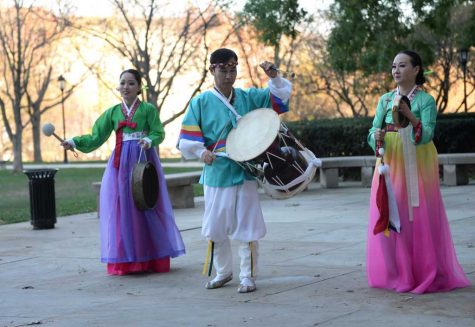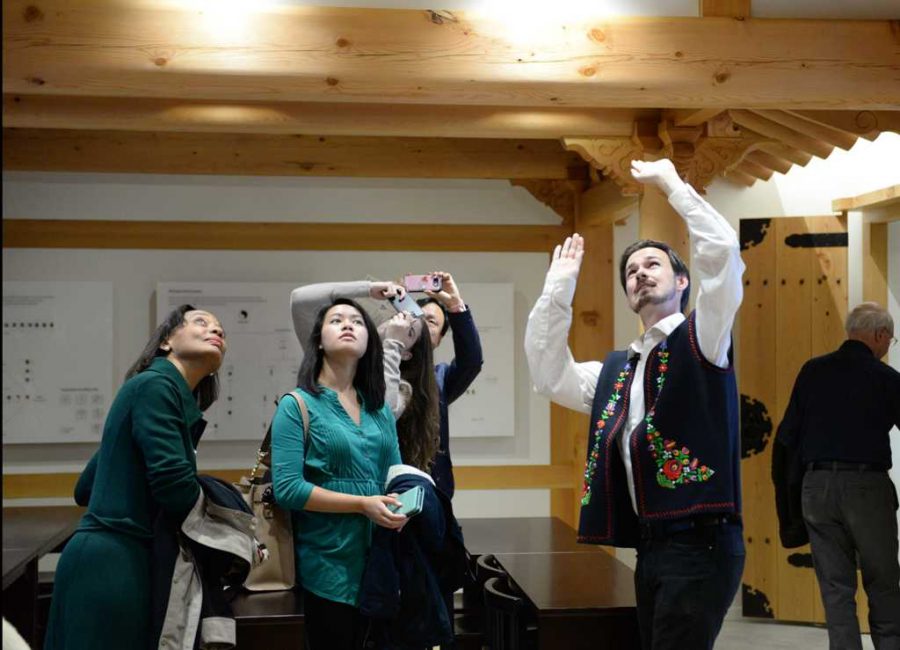Eight years and nearly $850,000 later, Pitt unveiled its 30th Nationality Room, the Korean Heritage Room, Sunday in the Cathedral of Learning with traditional Korean dancing, singing and celebrating.
On Nov. 15, Pitt students, community members and administrators celebrated the opening of the Korean Heritage Room in room 304 of the Cathedral of Learning. Open for classes next semester, the Korean room will be the 30th Nationality Room and the first addition since 2012. The celebration began with a dedication ceremony in Heinz Memorial Chapel, followed by a reception in the Commons Room of the Cathedral of Learning and concluded with a banquet at the Pittsburgh Athletic Association.
According to Young Hye Lim, a member of the Korean Central Church of Pittsburgh and the Korean Heritage Room Committee, which oversaw the creation of the room, the Korean community has worked to create this room since 2007. For Lim, the room will serve as a permanent piece of Korea for Pittsburgh students to experience.
“I’m getting old, some people have moved away, but this classroom stays here,” Lim said. “Some other people who didn’t have interest before, will now.”
At the dedication ceremony, co-chair of the committee David Kim said the committee’s goal was to make a room that motivates creative thought and combines 14th century Korean culture and modern technology, including an LCD screen.
“This room will serve as an incubator for collaborative thinking across all cultures,” said David Kim.
Among other speakers were Bong Ryol Kim, architect and president of Korea National University of Arts; E. Maxine Bruhns, director of the Nationality Rooms and Intercultural Exchange Programs; Mark A. Nordenberg, chancellor emeritus; David Kim, co-chairman of the Korean Heritage Room Committee; and Gheewhan Kim, consul general of the Republic of Korea in New York.
Nordenberg, who accepted the key to the room on behalf of Chancellor Gallagher, stressed that Pitt has an “extraordinary presence of alumni in South Korea.” He added, “There is an unbreakable bond between our countries.”
“This room will stand as a perpetual reminder of the miraculous transformation [South Korea] has made to a global economic power,” Nordenberg said.
The Korean Central Church of Pittsburgh, Korean United Presbyterian Church of Pittsburgh, Pittsburgh Korean Assembly of God and Mt. Zion Korean Church collaborated to bring choir singing, drum dancing and taekwondo to the ceremony. These organizations funded the festivities through donations from community members and organizations from both Pittsburgh and Korea.
According to Lim, Korean Central Church of Pittsburgh members cooked the traditional Korean food at the festival, such as cinnamon spice tea, kimbap — a rice roll filled with vegetables — and tteok — rice cake.
Following the formal dedication ceremony — which concluded with a performance of “Arirang Fantasy,” composed by Sung Hwan Choi and performed by the Pittsburgh Korean Philharmonic— was a reception next door in the Commons Room of the Cathedral of Learning. At the reception, audience members watched taekwondo and performances from choir and dance groups, including Korean Traditional Dance, Korean Children’s Small Drum Dance and Korean Children’s Choir. The groups were either a part of the sponsoring organizations or invited by the Korean Central Church of Pittsburgh, according to Lim. Lim said she could not estimate the number of people that attended the event.

People crowded the usually spacious ground floor of the Cathedral for a variety of Korean foods, performances by local Korean cultural groups and guided tours of the new Nationality Room. Many of the female attendees and performers wore Hanboks, traditional Korean dresses, while male performers wore either versions of Hanboks or the traditional taekwondo robes, doboks.
“My husband is the official photographer for the Nationality Room, so I’ve gotten to see pictures throughout the whole process of construction,” Pittsburgh native Ruth Kim said of the photos of workers assembling the hand-carved wood that now fills the room. “I think the Nationality Rooms are a big part of the Pittsburgh community, and it’s great to see this one represent a newer group of immigrants.”
Bong Ryol Kim said he based the room off of the Hall of Enlightenment, or myung-ryoon-dang, in the Royal Academy of Seoul, a place of education, built during the Joseon Dynasty. In the back of the room, wooden doors fold down to turn the room into a square — resembling the traditional Korean room — or brought up to a reveal an area enclosed by windows — resembling the Korean design of classrooms leading to courtyards.
For John Kang, a member of the Korean Central Church of Pittsburgh, the room is a source of pride.
“I understand this has been a longtime goal, and they put in a lot of fundraising,” Kang said. “As a member of this society, I am proud to see this happening.”


